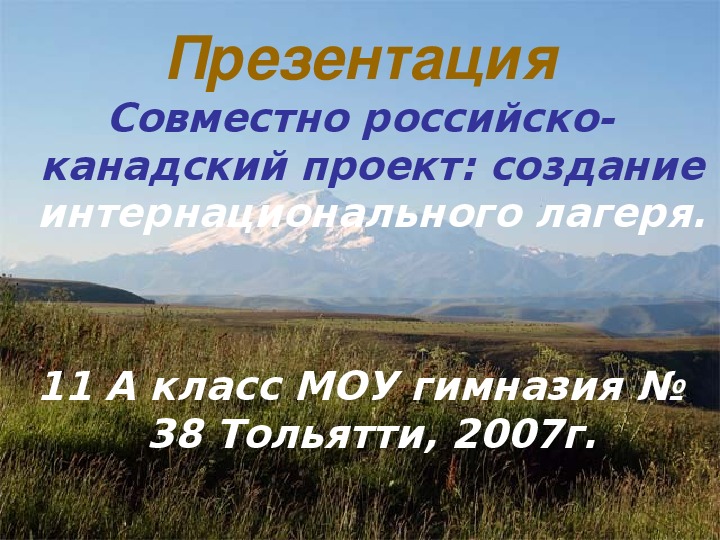Презентация к проекту "Создание международного российско-канадского лагеря.Quebec".
Презентации учебные
ppt
английский язык
9 кл—11 кл
03.09.2017

Презентация, подготовленная учащимися 11 класса в рамках работы над проектом "Создание международного российско-канадского лагеря".
В презентации описываются цели, задачи создания международного детского лагеря. Кроме того, маршрут поездки до места назначения, описание места, распорядок дня, культурная программа.
С помощью презентации можно познакомиться с природой, достопримечательностями канадской провинции Квебек.Возможно использование на уроках по теме "Страноведение".
Quebec.ppt
Architecture
•Quebec’s architecture has
characteristics that are peculiar
to it. The European influence,
Quebec’s climate, and the large
size of its families contributed to
shape the architecture of
Quebec’s buildings.
•In days gone by, buildings had
to be adapted to the harshness
of winter while also providing
the possibility of housing
families of ten members. Both of
these constraints were reflected
in buildings, on the inside as
well as externally.
Visual Arts
• The visual arts include the
following fields:
multimedia art, video art,
the textile arts, drawing,
etching, holography,
installation, painting,
performance, photography
and others.
• Quebec numbers about 75
selfmanaged arts centers,
75 centers devoted to
contemporary art, and
close to 180 professional
art galleries.
• Quebec is very open to
cultural exchanges in the
visual arts field. It
produces a great number
of events attract visitors
from everywhere and
foreign artists.
• To cite a few examples,
these include the Mois de
la Photo a Montreal,
Quebec’s international
festivals of the performing
arts, and missions related
to the visual arts.
Cinema
• The first film that was shot in
Quebec was “Dance
indienne”, in 1896, by the
Lumière Brothers. It was not
before the 1950's, however,
that Quebec's film industry
took off. Productions from
that period dealt with
everyday life in Quebec. In
1956, the French section of
the National Film Board, the
Office national du film (ONF),
was moved from Ottawa to
Montreal, which contributed
to heighten the enthusiasm
of Quebec's film makers.
• Today, film making in
Quebec has matured.
The presence of many
productions in
internationally reputed
festivals clearly
demonstrates this.
Films by producers
such as Denys Arcand,
Manon Briand, Gilles
Carle, Franzois Girard,
Carole Laure or Denis
Villeneuve have
contributed to give
Quebec wider visibility.
Dance
• Although the dance is still a relatively young art
here, Quebec's dance creations are nevertheless
renowned throughout the world. Over the last 20
years, Quebec’s choreographers have
contributed, by their creations, to make Quebec
shine abroad with a unique blend of originality,
innovation and quality. Groups such as the
Compagnie Marie Chouinard, the La La La Human
Steps company, the Grands Ballets Canadiens de
Montreal, Carbone 14 (in French only) and several
others have given Quebec an unequalled
reputation in the dance. For close to 15 years
now, Montreal has built a reputation as a very
dynamic choreography centre in North America.
Literature
• Quebec's Frenchlanguage literature
is relatively young. The first
published Quebec writings
appeared around the midnineteenth
century. These were part of a
nationalist trend and depicted a
rural society oriented towards the
family, land and religion. Novels
celebrating rural life included
“Menaud, maître draveur” (1937) by
Felix Antoine Savard, “Le
survenant” (1945) by Germaine
Guèvremont, and “Trente arpents”
(1938) by Louis Ringuet (the
pseudonym of Philippe Panneton).
• This trend lasted until the Second World War and
then, in the postwar years there emerged a
preference for novels depicting urban lifestyles.
This literature of observation, realistic and critical,
counts among its prominent titles “Les Plouffe”
(1948) by Roger Lemelin. It was in 1960, with the
Quiet Revolution, that Quebec's literary publishing
business began to develop more solid structures.
Emerging from the period known as the “great
darkness”, Quebec's Frenchspeaking writers laid
claim to their cultural identity. There was a
proliferation of new writers. Today, some 4 000
titles are published every year in Quebec.
Music
• Increasingly, Quebec's artists,
musicians, composers and
singers are making themselves
heard outside of its borders.
With its 5 000 professional
musicians and 200 composers,
Quebec is now a part of the
world music scene. Quebec
music ranges through all
musical periods, from medieval
to contemporary and all
musical genres, from
symphonic to electro acoustic.
Theatre
• Quebec theatre started to
take shape in the 19th
century, but began in
earnest in the 1930s,
moving from burlesque to
more popular theatre.
Whether
puppet theatre, modern
drama or multimedia,
Quebec's theatrical scene
today
offers aficionados, young
and old alike, a variety of
performance styles.
• Quebec takes up the
northeastern portion of the
North American continent. It is
divided into 17 administrative
regions, which cover a vast
territory of some 1,667,441
square kilometers (201,753
square kilometers of freshwater).
• Quebec is bordered to the north
by the Arctic Ocean, to the south
by the United States and New
Brunswick, to the east by the
Atlantic Ocean and the Gulf of
St. Lawrence, and to the west by
James Bay, Hudson Bay and
Ontario.
Floral emblems
• The blue flag (Iris
versicolor Linne) is
the new floral emblem
of Quebec. The blue
flag is an indigenous
spring flower that
grows on over half of
Quebec's territory,
from the St. Lawrence
Valley to the shores of
James Bay. The
heraldic fleurdelis
on the Quebec flag
was long considered
the floral emblem of
Quebec.
• The snowy owl
(Nyctea scandiaca),
which nests in the
tundra in northern
Quebec, is the
province's avian
emblem. Unlike other
owls, it hunts both day
and night during the
Arctic summer and
lives mainly on
lemmings. Black
stripes and spots dot
the plumage of young
birds, while old males
may be snowy white.
Official tree
• The Quebec government
chose the yellow birch (Betula
alleghaniensis Britton) as the
official tree of Quebec to
underscore the importance of
the forest to Quebecers. A
worthy representative of the
southern forest and balsam fir
yellow birch stand, the yellow
birch is an economic, social
and cultural symbol. It is not
only one of the bestknown
noble species in Quebec, it is
also noteworthy for the variety
of ways in which it can be
used and for its high
commercial value.
Hotel 71
71 rue Saint Pierre For
business or leisure, indulge
yourself in the mellow,
refined atmosphere and
resolutely modern decor of
this choice hotel. In
converting a prestigious
edifice dating back to the
19th century, the Hotel 71
has succeeded in bringing to
light every feature of the
building's majestic grandeur.
Материалы на данной страницы взяты из открытых истончиков либо размещены пользователем в соответствии с договором-офертой сайта. Вы можете сообщить о нарушении.
03.09.2017
Посмотрите также:
© ООО «Знанио»
С вами с 2009 года.
![]()
О портале

